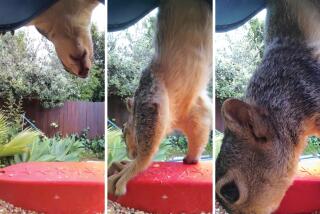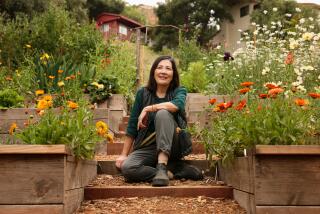Landing Gear
The airspace around Janet Foster’s Anaheim Hills home gets so crowded that it may be time for the FAA to get involved.
In the morning as she fills various feeders and prepares a breakfast mixture for the hummingbirds, there’s a virtual holding pattern of her feathered friends, jockeying for position to be the first bird on the perch.
“It’s like LAX out there sometimes with the hummingbirds; they can’t wait for the feeder to be filled,” she says.
Besides hummingbird food, Foster sets out sunflower seeds for a variety of birds including sparrows, finches, towhees and thrashers; suet (yes, congealed beef fat) for blackbirds; tangerines for orioles; thistle for goldfinches; and peanuts for scrub jays.
“I have a checklist of all the different species I see around the yard, and I see new ones all the time,” she says.
Like many in the county, Foster has turned her property into an oasis for the hundreds of wild bird species that live in or pass through Southern California.
“We have an extremely varied population of birds in our area, much more varied than in other parts of the country,” says Joy Bennett of Wild Birds Forever, an Anaheim Hills shop catering to bird aficionados.
“Because of our climate and the variety of food available, you’ll see some very interesting species, not just sparrows and crows.”
Foster is also a part of the National Wildlife Foundation’s Backyard Wildlife Habitat program, which enlists the help of anyone with space for a feeder or two to get involved with their environment by sustaining wildlife.
There are over 20,000 registered habitats in the U.S., and most participants do their part by setting out feeders, baths and birdhouses.
An attractive birdhouse may add a nice touch to a backyard, but don’t set your hopes too high that you’ll be getting an occupant. There are only certain species that like to nest in small spaces like birdhouses, and some are finicky.
If you live near a park or golf course, a bluebird may find its way to your birdhouse. “Bluebirds love cavities; they take possession of them,” says Dick Purvis, a retired engineer and bluebird expert in Huntington Beach. “They weren’t very common here, but each year we’re finding them in more areas.”
Other birds may use houses to hide from predators or inclement weather, but if you really want to provide a home for feathered friends, set out nesting materials.
“Dryer lint, string, yarn--birds will use these for nests and if a tree on your property is suitable for them, they may end up building there,” Bennett says.
A more immediate way to attract birds is with food. Bird feeders should be set high off the ground and away from any birdhouses since feeders tend to be noisy--it’s like getting a hotel room that’s too close to the pool.
The easiest feeder to put up is the platform style, which is like a small, shallow box with a screen on the bottom. Set it at least six feet off the ground, either on a pole or on a tree branch that’s far from a cat’s reach.
Food is placed in the feeder and any moisture runs out the bottom, which keeps mildew growth in check.
What do birds eat?
Anyone who’s planted winter rye grass to fill in their lawn’s brown spots and opened the door to a scene from “The Birds” will tell you to throw seed around and step back. Seed is quite popular.
“About 95% of birds in our area will eat black oiled sunflower seeds,” Bennett says. “If you want birds to come to your feeder, you can’t go wrong with them.”
Suet feeders cater to those birds that don’t care about their weight. In fact, they need to add.
Suet is necessary in some birds’ diets to provide energy for upcoming migrations or cold spells.
“You can buy it mixed with seeds or with insects or berries,” Bennett says. “I guess to a bird it’s quite appetizing. A lot of people make their own.”
A more pleasing alternative to suet (at least to us) is a mixture of peanut butter, honey and seed.
Hummingbirds are especially abundant in Southern California and they’re easily attracted with feeders. A sweet, sugary solution is used for their feeder bottles.
As neat as birds look, when it comes to eating they have no manners. You’ll find that bird food tends to get everywhere and that the feeder will need frequent cleaning.
Birds can exchange diseases with each other while dining at a feeder, which is why it’s a good idea to take the feeder down before refilling and washing it out.
Don’t forget the hummingbird feeder. Left alone in the sun, the sugary water will ferment, harming the birds. Another good reason to keep the feeding area sanitary is to prevent attracting mice and rats to the yard, which love a free snack the birds have left behind.
A metal disk, placed around the feeder pole or around the tree branch that leads to a feeder, can keep rodents away.
Speaking of washing, no bird habitat could be called complete without an old-fashioned birdbath. While the large plaster basin-style baths are still around, you may want to look at other types first.
“The reason you see so many birds near fountains is they’re attracted to the sound of running water,” says Trudy Hurd of the Sea & Sage Audubon Society in Santa Ana. “With a simple birdbath, they may not be aware of it from the air.”
It’s important to keep your yard safe for visiting birds. Their primary predator in suburbia is the house cat, and when a feline sets out to catch a bird, it may be hard to change its mind.
“I always say I trained my cat to be an Olympic jumper,” Purvis says. “I once set out a feeder that was 4 feet high, thinking the cat couldn’t jump to it, but he kept trying and eventually he did it. Then I moved it to 5 feet and he got there too. Finally I made it 6 feet high, and it took him a while but he finally got strong enough to jump it.”
Some people keep loaded squirt guns handy when their cat gets too close to the birds. Others make sure the cat is well fed before going outside to dull that hunting instinct.
“I had some feeders and birdhouses in a big tree in my yard that the neighborhood cats liked to climb,” says Sherri Miller of Placentia. “I attached a large band of smooth plastic to the trunk, which keeps the cats from getting up and bothering the birds.”
Once you start to attract flocks of flying birds to the yard, airborne accidents can happen. When a bird looks in a window from the outside, it sees itself, thinks it’s another bird and flies over to greet it, where it smacks into the glass.
“I’ve put hawk decals on my sliding glass door to keep them away, but I’ve still had birds hit the glass,” Foster says.
If you’re not interested in attracting birds that will feed on your fruit trees, put up decoy owls. These will scare them from your property, at least for a little while.
“They’ll probably stay away until they figure out that those owls just never move,” Hurd says. “It’s not a bad idea to change their position periodically. I heard of someone who even put some decoys on a toy train that moved on a track.”
Attaching foil strips to the branches of your fruit trees is a tried-and-true bird chaser.
“Anything that has movement will make the birds wary,” says Hurd. “That’s why they like statues.”
For more information on wild birds, contact:
* Sea & Sage Audubon Society, (714) 261-7963;
* Backyard Wildlife Habitat Program, National Wildlife Federation, (800) 432-6564;
* North American Bluebird Society, (714) 776-8878.
More to Read
Sign up for The Wild
We’ll help you find the best places to hike, bike and run, as well as the perfect silent spots for meditation and yoga.
You may occasionally receive promotional content from the Los Angeles Times.






